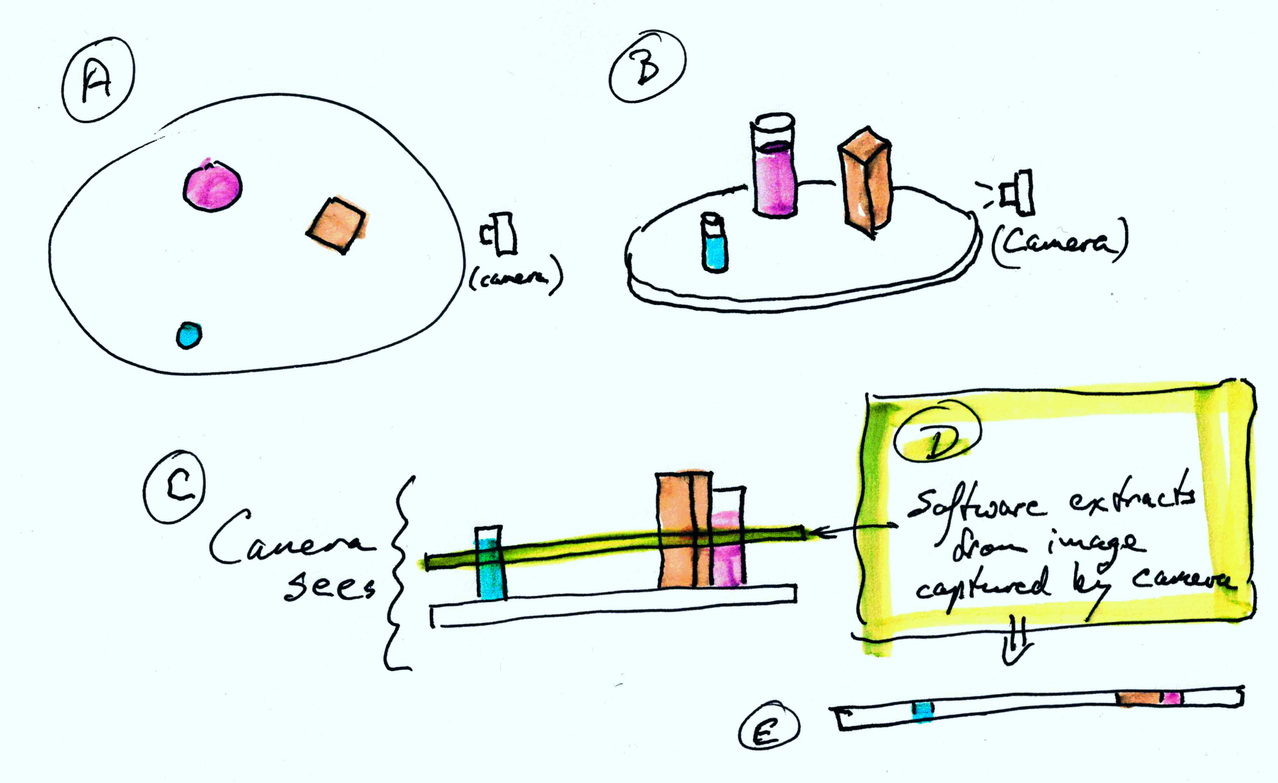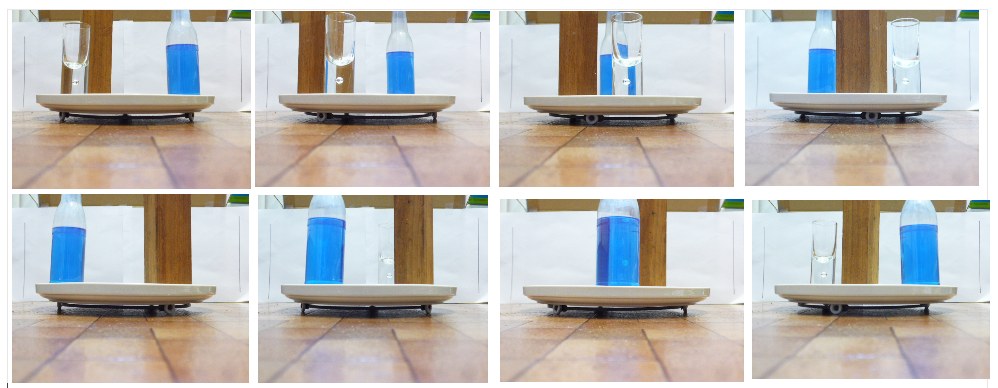This page presents a challenge. Please read at least down to "Thank you for reading this far"? (The reason I ask that will become clear, I hope.)
Can you make a working model of a CT scanner? And the software that converts the captured data into information?
(I'll get to why would you want to in a moment.)
By CT scanner, I mean the thing that lets doctors see inside patients without cutting them open.
I'm not proposing that you make a "real" CT scanner! (Whew.)
But I think you could make something which illustrates the principles. I haven't got all the answers, but here are some ideas which might give you a starting point.
I'd be delighted to post links from here to good reports of your efforts to make the scanner or the software!
I also hope, before too long, to have some data from a "scanner" that software types can use to test their code on.
Thank you for reading this far.
(Use the links to skip the early sections if you wish.)
- - - - - - - - - - - - -
Some people chase balls around a muddy field. Some people try to see different species of birds. Some people climb mountains.
Why would you choose to spend time on this? I don't know. I find tackling such things "fun"... whatever that is. For me, I think the gratification I get when I finally manage to Make Something WORK explains it. Maybe you have some of the same interests. Or others which will do as well. Will it be "good for something?" Well, maybe not. But do we care?
"CT" stands for "computed tomography". Tomography is "imaging by sections or sectioning that uses any kind of penetrating wave."
People speak of getting a "cat scan". (The "a" in "cat" is just there to pin down how we say "ct".) There is a particular CT scanner that is usually what is meant by "cat scan", but there are other scans that are also part of the general group. E.g. MRI's and PET scans.
The demonstrator I'm suggesting here is relevant to all of them.
(If you don't fancy trying the first part, don't worry! I've provided some images that will do for early work tackling the two parts of second part of the challenge. They are crude, but if your software can "work" on them, then it should work in better "data" to be "input", and give better results... but not fundamenally "different" results!
(The second part is Data Processing, which we will get to in a moment.)
I said I'd happily post links from here to good reports of any reader's efforts to achieve the goal of the challenge, or even a part of it. If you manage to capture some data, I'd be grateful if you were to share it, for the use of people who are more excited about doing other parts of the challenge.
The idea is to SIMULATE a CT scanner... AND, separately, create software to interpret the data it captures.
First you need something like a lazy Susan... a "platter" that spins easily.
On it, you would place a few objects... Start simple... maybe even REALLY simple, with just one opaque object on the platter. But, eventually, your scanner should work with a mixture of opaque, some clear or translucent, preferably colored.
In the image below, "A" and "B" are views of such a platter, with three objects on it.
(It isn't vital, but things will be easier for you if the cross-section of your objects is relatively constant, as you move along the axis perpendicular to the plane of the platter.)
You'd place a digital camera at the side of the platter, and take pictures across a plane parallel to the platter. "C" indicates what the camera would "see".
From the whole digital image, the software would extract a slice.
You would take a picture. And then rotate the platter a fixed amount.
And repeat that, over and over, until the platter had made a full revolution.
From that collection of images, the software that you... or a separate team you are collaborating with!... could, I think, generate an image similar to what we see in "A", the overhead view of what was on the platter.
Of course, many things have been simplified to make this "do-able"... (AND "explain-able").
The description is at a very early stage! Perhaps when better explained, the correspondence between elements of CT scanning and the challenge set out above... so far poorly may become more clear!

Those who know a bit about CT scanning and image generation, and who are thinking as they read this, will have noticed that I have... so far... shirked a great deal of the full story of CT image generation. The above will give you an image of a cross-section through the objects on the platter.. but that will be "all".
But that "simple" task is at the heart of the rest of what CT image generation offers. (More on this another time, I hope.)
Here's a set of photos done with the sort of set-up I am advocating...

As I've said in several places, a zip of those 8 images is available, if you want to skip the first challenge.
Once you've "caught your rabbit"... acquired a set of digital images, as described above... you can make your rabbit stew.
By the time you read this, it may be that others have created such sets, or maybe even data files created from them. (If you have, and it isn't listed here, please contact me! (Details at bottom of page.))
First, you'll read the R, G and B values of a band of pixels across a fixed row of each of the images, and create a data set for the next software to process.
Make your program elegant. It should be easy to change the data format, but, for now, I am going to suggest that the data be held in a simple text file, of a prescribed format. You can fetch...
http://wywtk.com/fea/sci/bio/ct/chal/ct-sample-data.txt
... to obtain a sample, which has a specification written out at the top of the sample data.
Then you create the "scan"! (I'll say more about that another time, perhaps. I can't give you all the answers. I am confident that it would be possible to create something like "A" in the diagram further up the page. Possible to create it from the data file recently explained.
If you found this of interest, please mention it in forums, give it a Facebook "like", or whatever. If you want more of this stuff, help!? There's not much point in me writing these things if no one feels they are of any use, is there? I'm not telepathic. Encouragement will be appreciated! Contact details below.
|
Unlike the clever Google search engine, this one merely looks for the words you type, so....
* Spell them properly.
* Don't bother with "How do I get rich?" That will merely return pages with "how", "do", "I"....
Please also note that I have three other sites, and that this search will not include them. They have their own search buttons.
It's both! Flat-Earth-Academy.com is something I started years ago. For a variety of reasons, I can't offer you httpS:// access there. (As you are not asked to input any information, that's moot, but it "worries" search engines.) So I'm moving to my new, all singing, and will do the httpS:// dance site, "WYWTK.com", and Flat-Earth-Academy is gradually acquiring pages there. (Well, HERE, as what you are reading is one of my "wywtk/fea" pages.)
Why "WYWTK"? It comes from "What You Want To Know".
![]() Page has been tested for compliance with INDUSTRY (not MS-only) standards, using the free, publicly accessible validator at validator.w3.org. It passes in some important ways, but still needs work to fully meet HTML 5 expectations. (If your browser hides your history, you may have to put the page's URL into the validator by hand. Check what page the validator looked at before becoming alarmed by a "not found" or "wrong doctype".)
Page has been tested for compliance with INDUSTRY (not MS-only) standards, using the free, publicly accessible validator at validator.w3.org. It passes in some important ways, but still needs work to fully meet HTML 5 expectations. (If your browser hides your history, you may have to put the page's URL into the validator by hand. Check what page the validator looked at before becoming alarmed by a "not found" or "wrong doctype".)
....... P a g e . . . E n d s .....